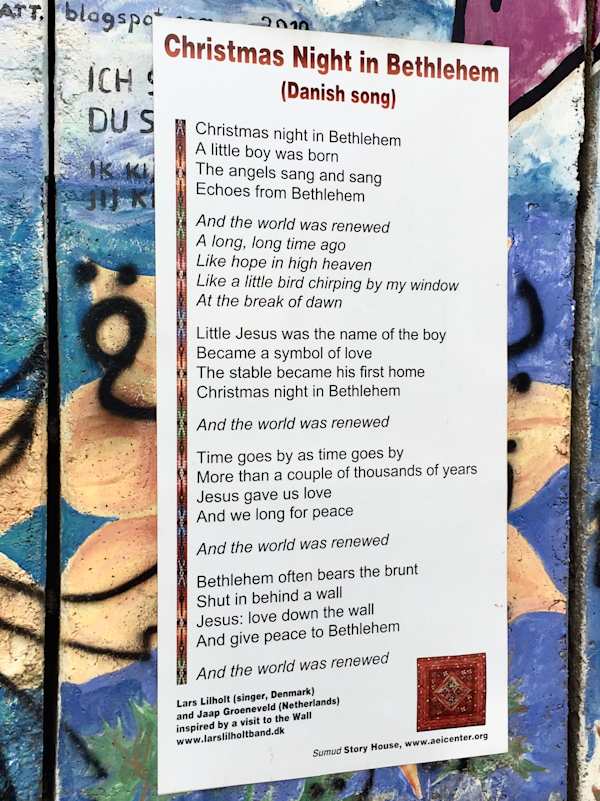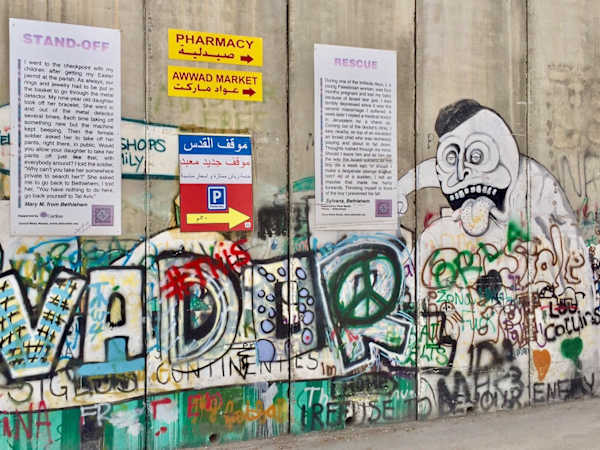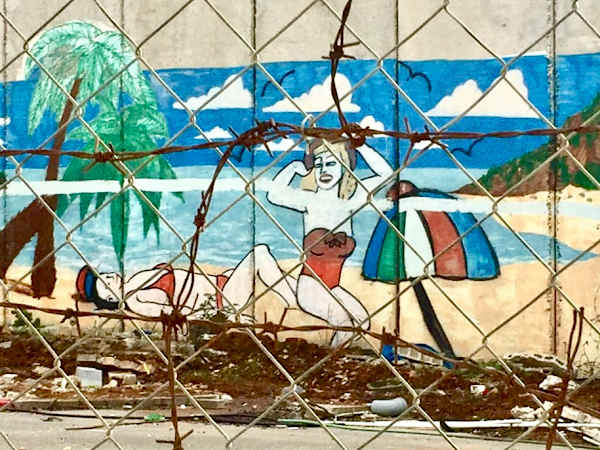Today is the second anniversary of the coordinated incursions by Hamas into southern Israel. During the initial incursions approximately 1200 people were killed, including 350 civilians who were attending a music festival. About 250 civilians and soldiers were also captured and taken into Gaza as hostages, which escalated the initial attacks into an ongoing war. The peace and love, noted in the above photograph, is difficult to find in southern Israel and Gaza today.
My Holy Land Trip (2017)
The above picture was taken in February 2017, as I walked along the wall separating Bethlehem from the rest of Israel. I was in the Holy Land with a church tour at that time. When my wife and I initially booked the trip we took out some travel insurance because we were unsure of what the political and military climate might be during our scheduled travel dates. We were fortunate; the Holy Land was relatively quiet at the time of our visit. Except for a few United Nation observers in the north and the presence of Israel troops at various gates and tourist sites, things were relatively peaceful.
We started our third day in Israel visiting Kafr Kanna, long revered as the site of Jesus’ first miracle (turning water into wine at a wedding in Cana). After that we headed south on Highway 6 towards Bethlehem. As we drove along, a wall (the “1949 Armistice Agreement Line” per my map) was off to the left much of the time. We had to go through that wall and a military checkpoint before we could enter the town where the Lord was born. Our first stop in Bethlehem was the oddly named Christmas Tree Restaurant. The falafels were good, but the “open air” restaurant was chilly. After lunch, our motor coach stopped for some shopping at the Bethlehem Souvenir Center (BSC) near Rachel’s tomb.
As I recall, everyone on my tour headed into the BSC to shop but me. I decided to wander down the road to check out the big wall that was just a block or so away. I quickly determined that the wall in that area had been turned into something of an art project – lamenting the existence of the wall and its impact on the citizens of Bethlehem. I walked along the wall for an hour or so, taking pictures, before heading back to the BSC and then onto Jerusalem with my tour group.
We would return to Bethlehem on Day 5 for a Mass at the Church of the Nativity and a visit to Shepherd’s Field, where, per the Gospel of Luke, an angel announced the birth of Jesus. The highlight of Bethlehem to me was not that church or field; it was the art and graffiti on that ugly concrete wall. The walk along that wall was a profound experience.
The Wall
The wall goes by many names such as the West Bank Barrier, the West Bank Separation Barrier, and Israel’s Separation Wall. Most of the wall was built by Israel following a wave of Palestinian violence and terrorism (e.g., suicide bombings in Jerusalem) during the Second Intifada, which began in September 2000 and ended in February 2005. On paper, as designed, the wall is about 440 miles long, weaving through both urban residential areas (like Bethlehem) and rural areas (e.g., olive farms). As of 2012, about 273.4 miles of the wall were completed. From what I have read, very little has been added since then.
The wall isn’t a border wall since there is no formal border. The 1949 Armistice border, commonly called the “Green Line,” was something of a de facto border, before the Six-Day War in 1967. Today’s “wall” is more than double the length of the green line as it weaves around the newer Jewish settlements. About 85% of the wall is on the Palestinian side of the green line. The concrete portion of the wall is about 30 feet high. A series of 84 gates (most seldom opened) and numerous “watchtowers” are incorporated into the wall. The wall has caused havoc and grief for the farmers, shop-owners, and residents in the area. Approximately 25,000 Palestinians are isolated from the rest of Palestinian territory. The International Court of Justice has deemed the wall to be illegal – but it still stands.
My Pictures of the Wall
During my hour, I probably walked for a third of a mile along the Bethlehem side of the wall. In that section of the wall, near Rachel’s Tomb, virtually every section of concrete was covered with paint or posters, some more professional looking than others. Some of the painted areas would probably be better categorized as vandalism than artwork.
Peace and Love: The picture at the top of the post features “Peace and Love.” Three people with white gloves and heart-shaped heads seem to be trying to breach the wall. They appear to be having some limited success. The heart-heads are red in color, the color of blood.
I have selected four other photographs that capture the spirit and variety of the wall art. Many areas were layered (e.g., sadly graffiti over art). I have no idea what the areas that I photographed in 2017 look like today. I am sure they have changed. I have seen a recent picture of President Trump painted on the wall. I have no idea when he was added.
The Watchtower: One of the many “watchtowers” is pictured on the left side of this photograph. I never could get a count of how many watchtowers were built along the path of the wall. I was alone most of the time that I walked along the wall, but I always had that feeling that I was being watched – maybe by someone in one of these towers – maybe on a monitor miles away. Note the immensity of the wall and the barbed wire on the top. This is a serious wall.
Christmas Night in Bethlehem: Interspersed along the wall are a series of 200 or so posters commissioned by the Arab Educational Institute (AEI). They add a little authority and credibility to the wall – making it more than just graffiti. This poster equates to what most Christians think about when they think of Bethlehem.
The poster is titled “Christmas Night in Bethlehem” and is identified as a Danish song. The song begin with “Christmas night in Bethlehem” before mentioning Jesus, love, and peace. The last five lines read:
Bethlehem often bears the brunt
Shut in behind a wall
Jesus: love down the wall
And give peace to Bethlehem
And the world was renewed.
VADOR: This photograph features layers and layers of graffiti under the watchful eye of a grotesque character, maybe an Israeli soldier in the watchtower. The red #THIS and green “peace symbol” give a little color to the Arabic word VADOR (meaning unknown). This photograph captures two other AEI posters entitled “STAND-OFF” and “RESCUE.” I like the combination of colors; including the graffiti, the yellow and red direction signs, and the red, white, and blue parking sign.
The Beach: The beautiful beach scene, with two bikini wearing females, reminds me of what Gaza could be if Trump (the real estate developer) had his druthers. The barbwire fence and the trash-filled roadway in the foreground reminds me of the Bethlehem that I saw. Quite a contrast.
A History Lesson
This all started back in 1917, during the First World War, when the British government (a war winner) announced its support for the establishment of “a national home for the Jewish People” in Palestine (then an occupied Ottoman region – the Ottomans being a war loser).
In the original letter, referred to now as the Balfour Declaration, Balfour wrote, “His Majesty’s Government view with favour the establishment in Palestine of a national home for the Jewish people, and will use their best endeavours to facilitate the achievement of this object, it being clearly understood that nothing shall be done which may prejudice the civil and religious rights of existing non-Jewish communities in Palestine ... .”
The above was much easier to write than to do. The American equivalent was “favoring the establishment of pioneer settlements – wherever pioneers want to settle in the West – without affecting the existing civil and religious rights of the indigenous people already living there.” Both the Balfour declaration and its American equivalent were followed by wars.
One of the solutions proposed for Palestine (and partially implemented in America) involves what is often referred to as the “two-state“ solution. In Palestine: divvy up the land – some for the Jewish state, some for the Palestinians. In America: “divvy up the land” equated to the creation of “Indian reservations.” The devil is obviously in the details – who gets what and how much. There are other possible solutions (e.g., the one big happy family) but these solutions are also easier said than done.
Israel and the Palestinians came very close to achieving a two-state solution in July of 2000, until Yasser Arafat, the chairman of the Palestine Liberation Organization (PLO) rejected Ehud Barak’s (what seem generous today) offer to create a Palestinian State. Both sides have and have had their neigh-sayers; Hamas was putting pressure on the PLO in July of 2000. Various Israel governments and political party leaders since Barak (e.g., Netanyahu) have not supported a two-state solution.
Shortly after Arafat rejected Barak’s offer, the situation deteriorated again – with the Second Intifada, suicide bombings, and the big ugly wall. The coordinated incursions into southern Israel, two years ago, just being the latest chapter. Sometimes it seems that neither side wants to end this war. And we, the U.S. government, via our financial aid and policies are complicit in the killing that takes place.
A Just War?
Is what is happening now in Gaza just?
The Catholic Catechism (CCC 2309) speaks of the traditional elements of what is called the “just war” doctrine. One of the clauses in the doctrine reads, “... the use of arms must not produce evils and disorders graver than the evil to be eliminated.”
In my opinion, Isreal’s response to the initial incursions was just. But somewhere along the way the use of arms against the civilian populations in Gaza has crossed the line. In my opinion the use of arms in Gaza now produces greater evils than the evil which needs to be eliminated.
I believe that the new pope shares my concerns, if not my opinion. On August 27, 2025, “Without naming Israel, Pope Leo specified that he was calling for full observance of ‘the duty to protect civilians and the prohibitions against collective punishment, the indiscriminate use of force, and the forced displacement of populations’” (per the Catholic News Service).
I sympathize with the predicament that the Israel government finds itself, with Hamas contributing to the mayhem by continuing to hold a few hostages (for whatever reasons). I sympathize with any army forced to fight an urban war where the bad guys are sprinkled amongst civilians. Given all that sympathy, I have reluctantly come to believe that the war has become unjust. I believe the world should put increased pressure on Isreal to end the war – or at least to comply with the just war doctrine.
President Trump has recently laid out a 20-point proposal for a comprehensive end to the war in Gaza. Several other Western countries have recently recognized (and thereby endorsed) a Palestinian state. The initial responses to Trump’s proposal have been encouraging but the devil is in the details and in the hearts of the belligerents – do they really want peace and love?




